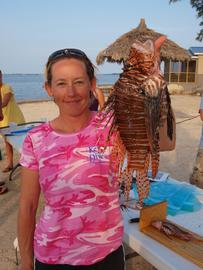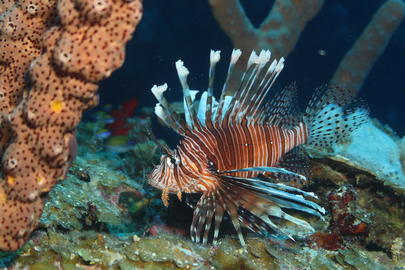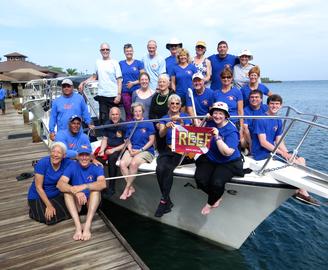Divers and snorkelers removed 1,518 invasive lionfish from Florida Keys waters during three Lionfish Derby events in 2011. Organized by REEF in partnership with the Florida Keys National Marine Sanctuary, the Florida Keys Lionfish Derby series began in 2010 to engage local communities in addressing the invasive lionfish issue.
Invasive lionfish in the western Atlantic are known to be voracious predators. Their unusual hunting behavior suggests that they could prey on most fish species within their gape size limits. Significant research by REEF researchers and others has been conducted looking at stomach contents of lionfish to identify prey. However, relatively few prey species have been identified because of the challenge of identifying partly digested prey. It is also difficult to know how well the identifiable diet reflects the unidentified portion.
Designing effective local management for invasive species poses a major challenge for conservation, yet factors affecting intervention success and efficiency are rarely evaluated and incorporated into practice. As part of a multi-year study with funding from NOAA Coral Reef Conservation Program and others, REEF and partners coordinated regional efforts by divers to cull invasive lionfish (Pterois spp.) on 33 U.S. Atlantic, Gulf of Mexico, and Caribbean protected coral reefs from 2013 to 2019.
Culling can be an effective management tool for reducing populations of invasive species to levels that minimize ecological effects. However, culling is labour-intensive, costly, and may have unintended ecological consequences. In the Caribbean, culling is widely used to control invasive Indo-Pacific lionfish, Pterois volitans and P. miles, but the effectiveness of infrequent culling in terms of reducing lionfish abundance and halting native prey decline is unclear.
Managing invasive Indo-Pacific lionfish (Pterois volitans and P. miles) in the Western Atlantic Ocean is beyond the capacity of natural resource organizations alone. In response, organizations have mobilized members of the public and citizen scientists to help. The authors used a structured survey to assess the activities and perceptions of 71 organizations that engage the public and citizen scientists in lionfish research and management throughout the invaded range of the Western Atlantic.
We are excited to share a new scientific paper that was published in the journal Global Change Biology last month. Researchers used REEF’s Volunteer Fish Survey Project database to answer crucial questions about the impacts of invasive lionfish as their range expands into new areas, such as Brazil. It is well known that predation by lionfish affects native fish populations, and this impact is likely exacerbated in certain vulnerable species.
If you haven't checked out the 2016 REEF Trips schedule yet, now's the time. We have an exciting lineup of destinations planned, and we hope you will join us. These trips offer a great introduction to fish identification for novice fishwatchers, and are a fun way for experienced surveyors to build their life-list while interacting with fellow ocean enthusiasts. We are also offering three of the ever-popular Invasive Lionfish Research Studies trips.
This seminal publication was created by REEF and our collaborators at NOAA, ICRI, the United Nations Environment Programme, Caribbean Environment Programme, SPAW-RAC, and the over 40 participants of the 2010 Caribbean Regional Lionfish Workshop. The guide provides best practices for lionfish control and management, including control strategies, outreach and education, research, monitoring, legal considerations, and ideas for securing resources and partnerships.
REEF, in collaboration with the University of Virgin Islands and Buck Island National Monument, took a major step last week in a novel study to better understand lionfish movement and factors that may influence that movement. The study, focusing on a 2km area of patch and continuous reef in St Croix, used innovative underwater tagging techniques pioneered by REEF to surgically implant transmitters into invasive lionfish within an array of receivers, allowing the team to pinpoint movement of the fish over the next year.
This paper examined the genetic source of the invasive Indo-Pacific lionfish in the Bahamas. Many of the samples used in this study were collected during REEF's lionfish research trips during 2007 and 2008. Two species, Pterois volitans and P. miles, were well established along the United States east coast before the first lionfish were reported from the Bahamas in 2004, where they quickly dispersed throughout the archipelago by 2007.



